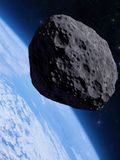Astronomers have officially identified a new celestial body, adding to Earth’s roster of quasilunar moons. The object, designated 2025 PN7, is a small Apollo-type asteroid detected in August 2023 by the Pan-STARRS 1 telescope in Hawaii. This discovery brings the total number of confirmed quasilunar moons orbiting alongside Earth to seven.
After detailed analysis of 2025 PN7‘s trajectory, researchers established that it maintains a 1:1 resonance with Earth, meaning it orbits the sun concurrently with our planet. This synchronization gives the illusion that Earth has an additional moon, even though quasilunar moons are not gravitationally bound to the planet. Instead, they follow their own trajectories around the sun and only appear to accompany Earth at specific times.
Characteristics of 2025 PN7
The distance between Earth and 2025 PN7 varies significantly. At its closest approach, the asteroid comes within 299,000 kilometers of Earth, while at its farthest point, it can drift up to 17 million kilometers away. For comparison, the Earth’s natural moon orbits at an average distance of 384,000 kilometers.
According to a publication in the Research Notes of the AAS, 2025 PN7 has been in a quasi-satellite phase since 1965 and is projected to remain in this state for approximately 128 years. Some estimates suggest that the asteroid will depart from its current path by 2083.
Understanding Quasilunar Moons
The discovery of 2025 PN7 adds to a growing list of quasilunar moons, which now includes seven confirmed bodies. These celestial objects belong to the Arjuna group, a collection of near-Earth asteroids that share a similar orbital path with Earth. Researchers believe that more such bodies may be identified in the future, as the study of the Arjuna group continues to expand.
While quasilunar moons orbit the sun in sync with Earth, mini-moons, another category of transient celestial bodies, have different characteristics. Mini-moons orbit Earth but typically do so in a horseshoe motion and exist for only short periods, ranging from weeks to months.
The seven known quasilunar moons include:
– 164207 Cardea
– 277810
– 2013 LX28
– 2014 OL339
– 469219 Kamoʻoalewa
– 2023 FW13
– 2025 PN7
The Pan-STARRS observatory has become a leading institution in the detection of near-Earth objects, leveraging its advanced 1.4 billion pixel digital camera—the largest of its kind globally. This technology has enabled astronomers to discover a variety of celestial phenomena, including comets and supernovae.
Understanding how moons are acquired varies among planets. For instance, gas giants like Jupiter and Saturn capture nearby bodies, while terrestrial planets such as Earth formed their satellites through collisions during the early solar system formation. The essential criterion remains that to qualify as a true moon, a satellite must be permanently bound by the planet’s gravity.
The discovery of 2025 PN7 not only enhances our understanding of the Earth’s celestial companions but also highlights the dynamic nature of our solar system. As astronomers continue to explore and investigate, the possibility of uncovering more quasilunar moons remains an exciting prospect.







